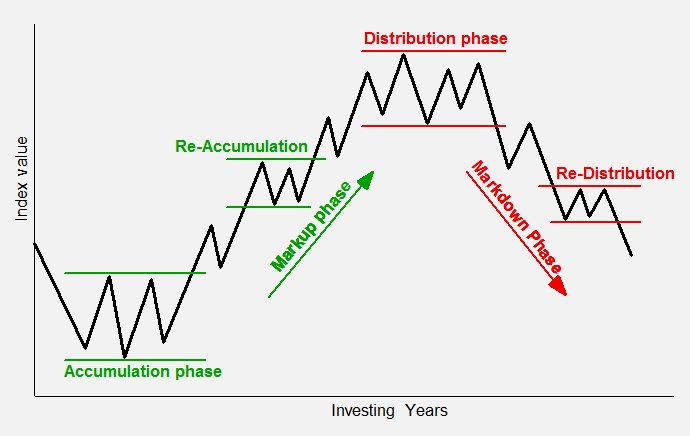Learning Dow Theory accumulates huge knowledge for you, as a trader, to sustain in the market.
Now, you must have questions like, how a three-character word can help you trade in the market. Well, it is about taking advantage of the potential price action points by identifying the market correctly.
1. Dow Theory – Introduction
Dow theory was introduced by Charles Dow- the founder of the Dow Jones company. He was also the first editor of the Wall street journal. He has written many theories and transitions in his life during 1900-1902 in form of many editorials. Let’s move further to understand exactly what is dow theory.
The raw statement made in the Dow theory is that there is a fundamental observation of bull and bear markets through the use of indices. The theory states that indices can predict the market sentiment in a stock market and back then, it was confirmed with proper proof.
Although the theory is hundreds of years old, the value it brings to your trading screen is enormous.
2. Dow Theory- Definition
Dow theory is a financial management theory that suggests that market trends are in existence despite the external noise in the market.
Here, the noise is denoted by the external news that turns the market to go sideways. Nonetheless, Dow theory of technical analysis suggests that even if the market goes sideways due to the immediate effect of news, there are still the existence of trends in the market.
3. Dow Theory – Paradigm
In Dow's theory, there are several rules which are developed by Dow to carry on with the trading and analysis. Some of the principles of Dow theory which you should remember at all times while you trade and analyse the charts.
3.1 Stock markets discount everything
If there is an economic shock in the market, the indices will move downward or upward as the company stock price will be affected by an economic shock.
3.2 There are three significant market trends
In practicing Dow theory, there will be primary, secondary and minor trends – a primary trend is a downtrend or uptrend, a secondary trend is the opposite movement of the stock, and a minor trend is a trend that lasts from hours to weeks in the market.
3.3 Always remember, indices confirm each other
If there are multiple indices trading in the stock market, it signals an identical trend going on in the market. When two indices move in a different direction, there is low confirmation of a trend.
3.4 The volume confirms the trend of the market
You should always remember that when there is an increase in volume, the market is deemed to be in an uptrend whereas, when the market is in a downtrend, there will be a decrease in volume.
3.5 The primary trends have three phases in Dow theory
Deriving a Dow theory in the stock markets analyses that different phase regulate the bear and bull markets. The three phases which we will discuss further in this blog are – the accumulation phase, public participation phase and excess phase.
3.6 It is deemed that trend continues unless there is an effect of reversal.
Trend reversals are the crucial turning point in a stock market where traders get instantly confused with secondary trends. Using Dow theory, traders can be cautious of the trend changes as the indices confirm the instant trend reversals in the market.
4. Three Phases of Dow Theory
There are three broad trends in Dow theory which is denoted by ‘phases’ which suggests that accumulation, public participation and excess phase together develop the trends initiated by Dow himself.

4.1 Accumulation Phase
Accumulation Phase is the first phase which occurs right after a bearish movement in the stock market.
As you can observe in the figure that accumulation phase is a stagnant phase where buyers and sellers are confused about the next movement in the market.
Due to the steep sell-off in the market, the traders are hesitant to enter into a trade. According to Dow theory, the accumulation phase targets the institutional buyers to acquire shares during the period and there are sellers already present from the steep sell-off. Therefore, it forms a certain phase and prices do not fall further, nor do they reach highs instantly.
It is suggested in Dow theory principles that the accumulation phase can last for a long time.
4.2 Public Participation Phase
In the second phase, public participation increases due to the stable movement of prices in the accumulation phase. In this situation, buyers build up which results in the buying movement.
More investors enter the market which shows positive sentiments, and it becomes evident that the price is going to improve. Thus, the public participation phase results in driving the market to reach new prices.
4.3 Excess Phase
The third phase, also known as the panic or excess phase is marked by the excess investment made by investors in a short period. Great speculation results during this stage as this are the ideal stage for profit booking.
A trader finds the opportunity using Dow theory to analyse the phases and make an entry or exit the trade. Indices confirm the market sentiment, bullish trend or bearish trend, volume, and reversal in the market which helps in deciding the entry phase for traders and investors.
5. Technical Analysis using Dow Theory
Now, we know, you must be curious about how Dow's theory works in technical analysis…
We have prepared the right answers for you to understand well and implement even better during your trading hours.
The fundamental aspect of Dow Jones theory of technical analysis works critically to prepare the answers for technical stocks. It induces the traders to pay more attention to the details that it has to offer for analysing the stocks using indices.
Close attention should be given to the market data, trends, reversals and side-way market. It succinct the buy or sell of an asset with the historical chart data and work as an indicator to predict the indices movement.
Using the theoretical standards of Dow theory and its phases, a trader can ensure to make profitable decisions during trading.
Let us remind you that your trading decisions are essential, and you should take it ensuring all the aspects of Dow theory.
For example, a particular trend is being followed in the Bank Nifty Index- it is in increasing trend and showing a bullish movement. Dow theory is ascertained when the Bank Nifty Index starts rising with the movement of phase 2 i.e., public participation increases. In this case, if you hold a stock which is included in the index of Bank Nifty, for example- ICICI Bank, then it is pertinent that it will show a similar effect until and unless there is an immediate effect of a news.




